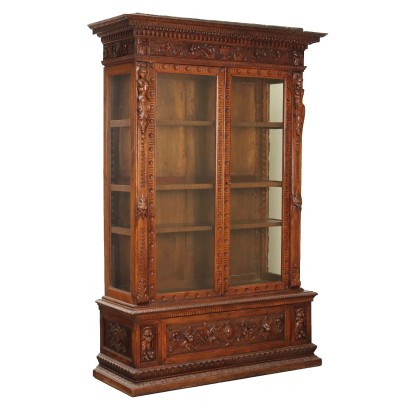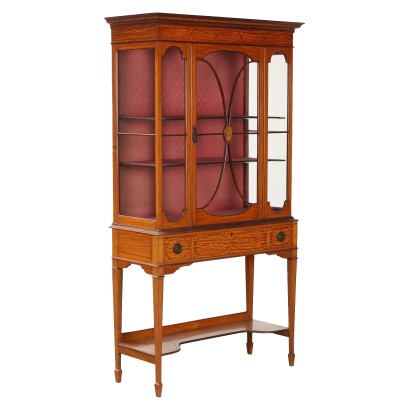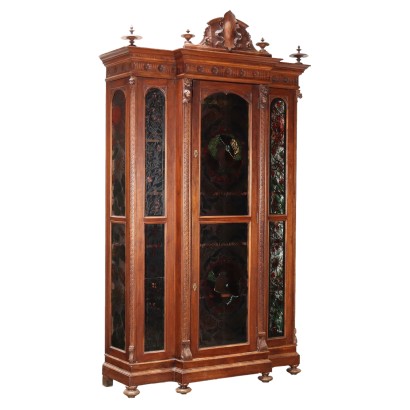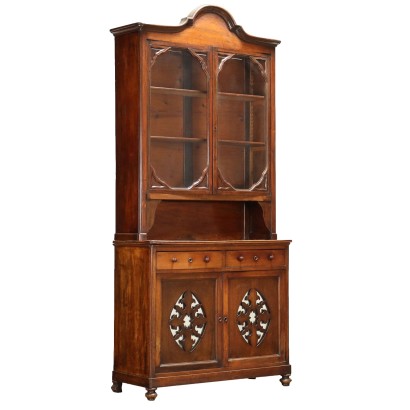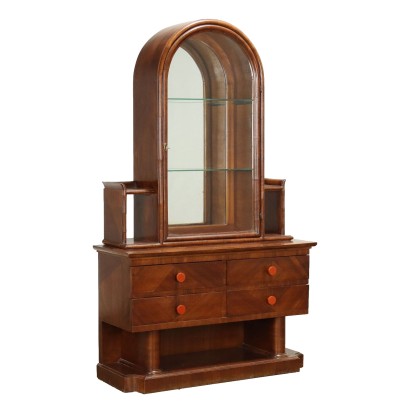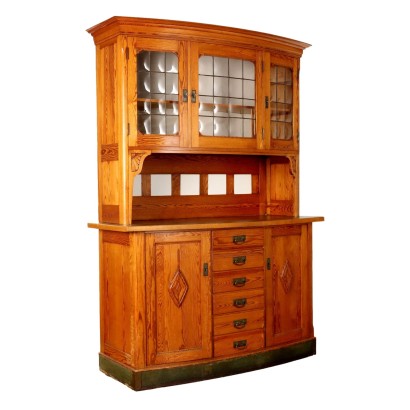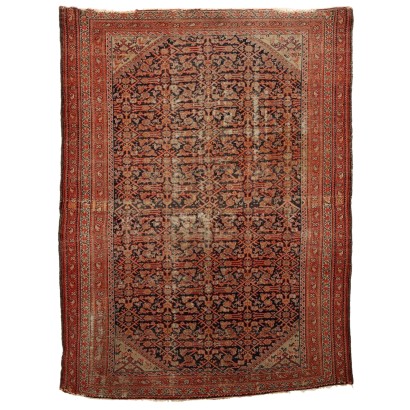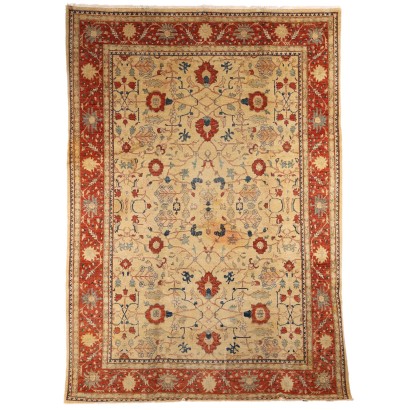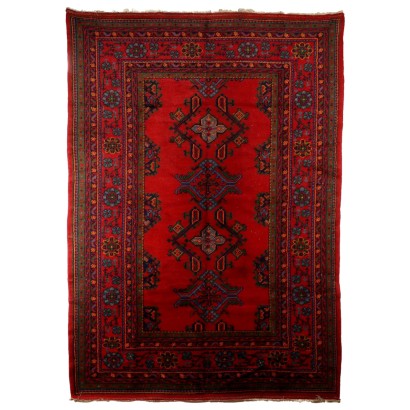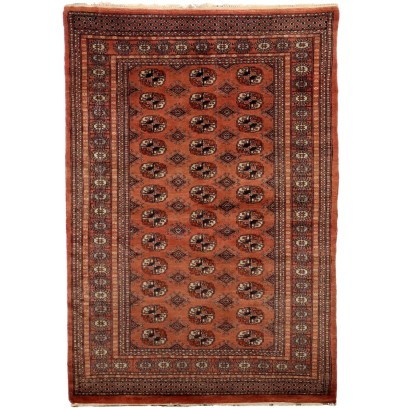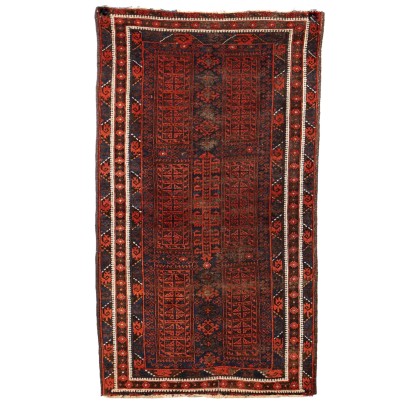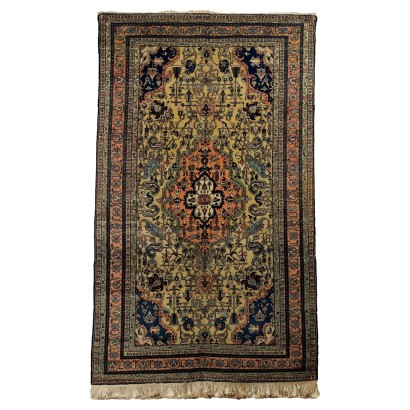Antique Neo-Renaissance Showcase Walnut Italy XIX Century - Italy, Late XIX Century
Features
Italy, Late XIX Century
Style: Neo-Renaissance (1820-1890)
Age: 19th Century / 1801 - 1900
Origin: Italy
Main essence: Silver Fir , Walnut
Material: Carved Wood , Glass
Description
Neo-Renaissance showcase in walnut, Italy, late 19th century. Showcase section equipped with a pair of glass doors, lower section with drawer. Richly carved with Renaissance-style elements, such as frets, phytomorphic and leaf elements, masks, cartouches and caryatids. The internal shelves have a Greek motif carved on the front edge. Fir interior. Glasses replaced.
Product Condition:
Product which, due to age and wear, may require restoration and re-polishing. We try to present the real state as fully as possible with photos. If some details are not clear from the photos, what is stated in the description applies.
Dimensions (cm):
Height: 230
Width: 151,5
Depth: 56
Additional Information
Style: Neo-Renaissance (1820-1890)
Nineteenth-century recovery and re-evaluation of forms and styles typical of the Renaissance.Find out more with the insights of our blog:
Classic Monday: a neo-Renaissance sideboard in dialogue with the past
The dictionary of antiques - Savonarola
Age: 19th Century / 1801 - 1900
19th Century / 1801 - 1900Main essence:
Silver Fir
Soft coniferous wood, used for rustic furniture or to build the chest, that is the structure, of furniture then veneered in more precious woods. It has been used since ancient times, its most valuable use is, in the Spruce variant, in the inlays of French antique furniture of the '700 . The spruce, more typical of northern Europe, in Italy grows mainly in the Eastern Alps at altitudes above 1300 m. The noblest use of this essence was in the construction of violins, guitars and cellos: Stradivari himself produced his famous violins with this wood.Walnut
Walnut wood comes from the plant whose botanical name is juglans regia , probably originally from the East but very common in Europe. Light or dark brown in color, it is a hard wood with a beautiful grain, widely used in antique furniture. It was the main essence in Italy throughout the Renaissance and later had a good diffusion in Europe, especially in England, until the advent of mahogany. It was used for solid wood furniture and sometimes carvings and inlays, its only big limitation is that it suffers a lot from woodworm. In France it was widely used more than anything else in the provinces. In the second half of the eighteenth century its use decreased significantly because mahogany and other exotic woods were preferred.Material:
Carved Wood
Glass
Other customers have searched:
Vetrine, vetrina, teca, vetrinetta, scansia, mobile, scaffale, libreria..
Approfondimenti
Consulta anche le migliori librerie e vetrine su FineArt:
Libreria 'Life' Roberto Monsani per Acerbis
Libreria, Giuseppe Speluzzi, Milano, ultimo quarto XIX secolo
Libreria anni '50 manifattura italiana
Libreria anni '60
Sideboard '503' Gianfranco Frattini per Bernini
Mobile Mario Vender anni '60
Trumeau Queen Anne, Inghilterra, 1705 ca.
Sull'antiquariato in generale dai un'occhiata anche a
Classic Monday: da un pezzo dei nostri magazzini alla storia dell'antiquariato
L'antiquariato dalla A alla Z: il Dizionario dell'Antiquariato
Il dizionario dell'antiquariato - Lastronatura
Il dizionario dell'antiquariato - Mascherone
Il dizionario dell'antiquariato - Natura morta
Il dizionario dell'antiquariato - Opificio
Il dizionario dell'antiquariato - Pastiglia
Il dizionario dell'antiquariato - Savonarola
Il dizionario dell'antiquariato - Rosone
Intaglio barocco con motivo a ricciolo
Approfondimenti
Consulta anche le migliori librerie e vetrine su FineArt:Libreria 'Life' Roberto Monsani per Acerbis
Libreria, Giuseppe Speluzzi, Milano, ultimo quarto XIX secolo
Libreria anni '50 manifattura italiana
Libreria anni '60
Sideboard '503' Gianfranco Frattini per Bernini
Mobile Mario Vender anni '60
Trumeau Queen Anne, Inghilterra, 1705 ca.
Sull'antiquariato in generale dai un'occhiata anche a
Classic Monday: da un pezzo dei nostri magazzini alla storia dell'antiquariato
L'antiquariato dalla A alla Z: il Dizionario dell'Antiquariato
Il dizionario dell'antiquariato - Lastronatura
Il dizionario dell'antiquariato - Mascherone
Il dizionario dell'antiquariato - Natura morta
Il dizionario dell'antiquariato - Opificio
Il dizionario dell'antiquariato - Pastiglia
Il dizionario dell'antiquariato - Savonarola
Il dizionario dell'antiquariato - Rosone
Intaglio barocco con motivo a ricciolo



